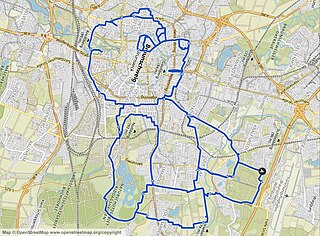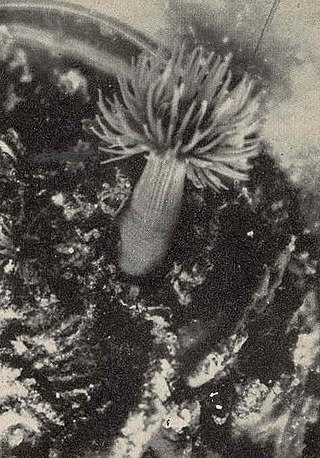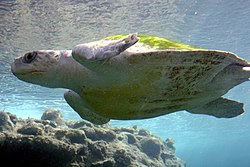Related Research Articles

Sea turtles, sometimes called marine turtles, are reptiles of the order Testudines and of the suborder Cryptodira. The seven existing species of sea turtles are the flatback, green, hawksbill, leatherback, loggerhead, Kemp's ridley, and olive ridley. Six of the seven sea turtle species, all but the flatback, are present in U.S. waters, and are listed as endangered and/or threatened under the Endangered Species Act. All but the flatback turtle are listed as threatened with extinction globally on the IUCN Red List of Threatened Species. The flatback turtle is found only in the waters of Australia, Papua New Guinea, and Indonesia.

The leatherback sea turtle, sometimes called the lute turtle, leathery turtle or simply the luth, is the largest of all living turtles and the heaviest non-crocodilian reptile, reaching lengths of up to 1.8 metres and weights of 500 kilograms (1,100 lb). It is the only living species in the genus Dermochelys and family Dermochelyidae. It can easily be differentiated from other modern sea turtles by its lack of a bony shell; instead, its carapace is covered by oily flesh and flexible, leather-like skin, for which it is named.

USS Loggerhead (SS-374/AGSS-374), a Balao-class submarine, was a ship of the United States Navy named for the loggerhead, Caretta caretta, a very large, carnivorous sea turtle common in the warmer parts of the Atlantic, Pacific, and Indian Oceans.

GPS drawing, also known as GPS art, is a method of drawing where an artist uses a Global Positioning System (GPS) device and follows a pre-planned route to create a large-scale picture or pattern. The .GPX data file recorded during the drawing process is then visualised, usually overlaying it as a line on a map of the area. Artists usually run or cycle the route—while cars, vans, boats and aeroplanes are utilized to create larger pieces.

The loggerhead sea turtle is a species of oceanic turtle distributed throughout the world. It is a marine reptile, belonging to the family Cheloniidae. The average loggerhead measures around 90 cm (35 in) in carapace length when fully grown. The adult loggerhead sea turtle weighs approximately 135 kg (298 lb), with the largest specimens weighing in at more than 450 kg (1,000 lb). The skin ranges from yellow to brown in color, and the shell is typically reddish brown. No external differences in sex are seen until the turtle becomes an adult, the most obvious difference being the adult males have thicker tails and shorter plastrons than the females.
Natal homing, or natal philopatry, is the homing process by which some adult animals that have migrated away from their juvenile habitats return back to their birthplace to reproduce. This process is primarily used by aquatic animals such as sea turtles and salmon, although some migratory birds and mammals also practice similar reproductive behaviors. Scientists believe that the main cues used by the animals are geomagnetic imprinting and olfactory cues. The benefits of returning to the precise location of an animal's birth may be largely associated with its safety and suitability as a breeding ground. When seabirds like the Atlantic puffin return to their natal breeding colony, which are mostly on islands, they are assured of a suitable climate and a sufficient lack of land-based predators.

The National Marine Park of Zakynthos founded in 1999, is a national park located in Laganas bay, in Zakynthos island, Greece. The park, part of the Natura 2000 ecological network, covers an area of 135 square kilometres (52 sq mi) and is the habitat of the loggerhead sea turtle. It is the first national park established for the protection of sea turtles in the Mediterranean.

Sea turtle migration is the long-distance movements of sea turtles notably the long-distance movement of adults to their breeding beaches, but also the offshore migration of hatchings. Sea turtle hatchings emerge from underground nests and crawl across the beach towards the sea. They then maintain an offshore heading until they reach the open sea. The feeding and nesting sites of adult sea turtles are often distantly separated meaning some must migrate hundreds or even thousands of kilometres.

Polybius henslowii is a species of crab, the only species in the genus Polybius. It is a capable swimmer and feeds in open water in the north-east Atlantic Ocean and western Mediterranean Sea.

Planes minutus is a species of pelagic crab that lives in the North Atlantic Ocean. It is typically less than 10 mm (0.4 in) long across the back, and is variable in colouration, to match its background. It may have been the crab seen by Christopher Columbus on Sargassum weed in the Sargasso Sea in 1492.

The Gnaraloo Turtle Conservation Program (GTCP) is an environmental organisation based at the Gnaraloo pastoral station and run by the Gnaraloo Wilderness Foundation, a not-for-profit organisation. The aim of the GTCP is to identify, monitor and protect the nesting beaches of loggerhead sea turtles found at two locations on the Gnaraloo coastline. These two rookeries contribute to the South-East Indian Ocean subpopulation of loggerhead turtles, with other major nesting sites for this sub-population at Dirk Hartog island and Exmouth. This is within the southern boundaries of the Ningaloo Coast marine area, a UNESCO World Heritage Site.
Cape Byron Marine Park is one of four marine parks in New South Wales, Australia, and is the most recently sanctioned. The Cape Byron Marine Park is located in Northern NSW and extends 37 kilometres (23 mi) from the Brunswick River to Lennox Head. The marine park extends out to 3 nautical miles which dictates the border between state and federal jurisdiction. The marine park covers an area of 220 square kilometres (85 sq mi) and includes a variety of marine terrain including beaches, rocky shores, open ocean and the tidal waters of the Brunswick River and its tributaries, the Belongil Creek and Tallow Creek. The Cape Byron Marine Park was declared in 2002 and the zoning plan was implemented in April 2006. Of the 15 distinct marine ecosystems identified within the Tweed-Moreton bioregion, the Cape Byron Marine Park supports 10 of these.
The Bald Head Island Conservancy (BHIC) is a non-profit organization founded November 7, 1983. BHIC's mission is barrier island conservation, preservation and education. It is located in the Smith Island Complex in Brunswick County, North Carolina, which includes Bald Head Island, Middle and Bluff Islands, all of which are bounded by the Cape Fear River and the Atlantic Ocean. BHIC sponsors and facilitates scientific research that benefits coastal communities and provides numerous recreational and educational activities for students, educators, visitors, and residents. In coordination with various organizations, partnerships and collaborations, the Conservancy has led the nation in conservation and research efforts and is uniquely poised to become a leader in Barrier Island Conservation world-wide.

Diadumene leucolena, commonly known as the white anemone or ghost anemone, is a species of sea anemone in the family Diadumenidae. It is an inconspicuous species found in the intertidal and subtidal areas of the northeastern Atlantic Ocean, the Caribbean Sea and the northern Pacific Ocean. Diadumene, "diadem-bearer", referring to the crown of tentacles, is a female form intended to bring to mind the Diadumenos, the renowned Greek sculpture of an athlete crowning himself with the victor's ribbon diadem.
Thamihla Kyun Wildlife Sanctuary is a protected area in Myanmar, located on the 0.88 km2 (0.34 sq mi) small uninhabited Diamond Island near the mouth of Pathein River. It was established in 1970 and is part of Ngaputaw Township in Ayeyarwady Region. It is managed by the Forest Department.

The Cyprus Mediterranean forests is a terrestrial ecoregion that encompasses the island of Cyprus.
Jeffrey Polovina is an American marine scientist. He is known for creating the marine ecosystem model Ecopath.
Lily Venizelos is a Greek conservationist.

Graeme C. Hays is a British and Australian marine ecologist known for his work with sea turtles and plankton. He is the Alfred Deakin Professor of Marine Science at Deakin University, Australia.

Christine Figgener is a German marine conservation biologist, author, science communicator, and ocean advocate recognized for her work in sea turtle conservation, the fight against plastic pollution, and the empowerment of women in STEM. She is best known for documenting the removal of a plastic straw from a sea turtle's nose in a YouTube video that went viral in 2015. This video, which was featured in popular media outlets such as National Geographic, HuffPost, The New York Times, ABC News, and CNN, highlighted the dangers of plastic pollution on marine wildlife and was a catalyst for the global anti-straw movement that led to several straw bans by businesses such as Starbucks, Disney, and Alaska Airlines.
References
- ↑ "ADELITA: A SEA TURTLE'S JOURNEY". Kirkus Reviews . June 30, 2020. Retrieved 18 March 2021.
- ↑ "Spectacular sea turtles and the threats they face". CNN. December 15, 2020. p. 11 of 23. Retrieved 18 March 2021.
- ↑ Yong, Ed (February 24, 2011). "Turtles use the Earth's magnetic field as a global GPS". National Geographic . Archived from the original on April 14, 2021. Retrieved 18 March 2021.
- ↑ "Loggerhead sea turtles go the distance". CNN. Environmental News Network. July 19, 1999. Retrieved 18 March 2021.
- ↑ Weaver, Meg (October 6, 2008). "Wallace J. Nichols on Turtles… and Tacos". National Geographic. Archived from the original on June 22, 2021. Retrieved 18 March 2021.
- ↑ "Mexican, Japanese and U.S. Fishermen Celebrate Sea Turtle's Epic Journey". Underwater Times . December 8, 2006. Retrieved 18 March 2021.
- ↑ "East Pacific Sea Turtle Tracking Project (1996-1997)". NASA. OBIS-SEAMAP. Blue Ocean Institute. Retrieved 18 March 2021.
Ancillary Keywords: Adelita
- ↑ Etnoyer, Peter (February 7, 2009). "Satellite tracked sea turtle swims in Google Ocean". Deep Sea News. Retrieved 18 March 2021.
- ↑ "Sea Turtle Research of J. Nichols '89 Featured in Magazine, on PBS' Nature". DePauw University. April 12, 2007. Retrieved 18 March 2021.
- ↑ "About". Voyage of the Lonely Turtle. PBS Nature. May 10, 2010. Retrieved 18 March 2021.
- ↑ "Sea Turtle Navigation". PBS Nature . May 29, 2008. Retrieved 18 March 2021.
